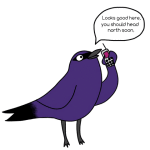We’ve been enjoying an unusually warm winter but that doesn’t mean anything to the Purple Martins. They start showing up this time of year regardless of the severity of the winter. For them, it’s gettin’ on spring! If you are a Purple Martin host, it’s time to get your house or gourds cleaned out and put up. If you aren’t a Purple Martin host yet, consider it! The males are a beautiful glossy purple color all over while the females and young of the year are purplish on their backs and dusky underneath.
These birds are quite entertaining as they glide, dip, and soar in search of flying insects. Although it is often advertised that they eat thousands of mosquitoes a day, there is no evidence that they actually eat them, as mosquitoes usually fly lower than the typical foraging altitude of a martin. Still, Purple Martins make good neighbors, feeding on other insects and entertaining us with their aerial prowess.
Every year we get calls at the Gulf Coast Bird Observatory about Purple Martin scouts. This is a misnomer that has been widely spread. In actuality, the early arrivals are simply adults that are returning to claim their nesting site from the previous year. The subadults (young birds from the previous year) arrive about six weeks after the adults. If you think about it, how could there be scouts anyway? Unless birds are carrying cell phones these days, the early arrivals have no way of communicating anything to the birds that are still on the wintering grounds!
Purple Martins and humans have a long history of co-habitation. Due to cavity competition with introduced House Sparrows and European Starlings, eastern Purple Martins have been almost entirely dependent on human-made martin houses for nesting since the early 1900’s. Paradoxically, martins west of the Rocky Mountains still nest almost exclusively in old woodpecker holes or natural cavities. Few other species show such a marked geographic difference in nesting habits or have the long-standing relationship with humans that Purple Martins do.
Purple Martins are the largest swallow in North America and should not be confused with our other swallow species. Birds nesting under bridges, especially highway overpasses, are typically Cliff or Cave Swallows, which can be identified by the light patch on their rump. If you have swallows nesting in your porch eaves, they are most likely Barn Swallows which have long forked tails. All of these species make nests out of mud rather than using human-provided houses like Purple Martins.
There are many places along the coast where you can see Purple Martins during the spring and summer. This includes both rural and city environments, as they will nest in most areas where the terrain is open enough. Martins show high site fidelity, returning year after year to same nesting site if it is properly maintained, although it may take several years for them to establish a colony in newly installed housing.
Martins have very specific aerial space requirements and housing should be placed in the most open spot available. Generally, it needs to be at least 30 to 120 feet from human housing and there should be no trees taller than the housing within 40 feet. Patience is the key to being a successful Purple Martin landlord. If you want more information about Purple Martins, check out the Purple Martin Conservation Association’s webpage.
Sue Heath is the Director of Conservation Research of the Gulf Coast Bird Observatory. The GCBO is a non-profit organization dedicated to saving the birds and their habitats along the entire Gulf Coast, and beyond into their Central and South America wintering grounds.

